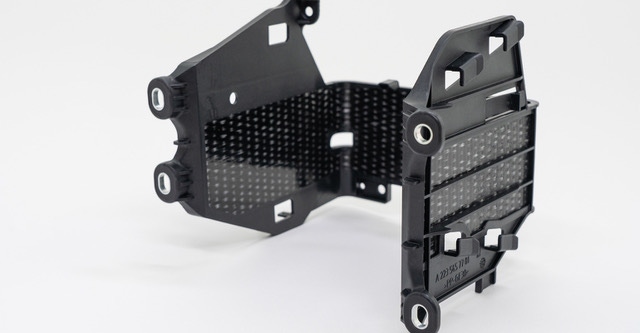Lightweight Bracket Firmly Fixes Driver-Assist Battery
Continuous-fiber-reinforced thermoplastic composite performs under sustained dynamic stress with no risk of short circuit, unlike metal alternatives.
December 28, 2021

Mercedes-Benz has turned to a continuous-fiber-reinforced thermoplastic composite for fabrication of a mission-critical structural bracket. The bow-shaped component supports a battery that supplies electricity to the Intelligent Drive automated driver-assistance system in the automaker’s S-Class in the event of a sudden power failure.
The bow-shaped bracket is made by Poeppelmann Kunststoff-Technik GmbH & Co. KG (Lohne, Germany) using polypropylene-based Tepex Dynalite 104-RGUD600(4)/47% from Lanxess. The two-stage manufacturing process combines forming (draping) of the composite with injection molding.
“The composite design means that the finished product can be as much as 40% lighter than a version made from metal,” said Joachim Schrapp, an expert in lightweight design at Poeppelmann. “The injection molding step also enables functions to be integrated that not only make it much easier to install the bracket but also cut down on the logistical workload. All this has a beneficial effect on manufacturing costs.”
The bracket’s job is to hold the battery, which weighs around 10 kilograms, firmly in place in the rear compartment of the vehicle by clamping alone, even when it is subjected to the considerable forces that occur in a collision. The bracket is designed to ensure that most of the forces are transferred from the points of application via the continuous glass fibers of the composite material. This makes the most of the strength and stiffness provided by the Tepex blank.
“The advantage of our composite is that unlike fiber-reinforced injection-molded compounds, for example, it does not suffer creep under high sustained stresses and, therefore, does not deform. This ensures that the battery is held in place permanently,” said Philipp Maas, Sales and Project Manager for Tepex at Lanxess. The blank also boasts a high degree of fatigue strength, which ensures that the material does not become brittle and crack over time as a result of frequent or heavy vibrations such as those caused by potholes.
The functions integrated in the bracket during the injection molding stage include guides for cables as well as mounts and fasteners for two control units. Says Schrapp: “These two pieces of equipment are simply clipped into place during installation, so you don’t have to spend time screwing them in.”
The PP matrix of the Tepex material is reinforced with four layers of continuous glass fibers, most of them arranged in one direction. The injection-molded compound, which is reinforced with short glass fibers, is also polypropylene-based. “Since the bonding matrix and the injection-molded material match, this creates a very strong bond between them. Coupled with the high specific stiffness of the composite, this leads to gains in both strength and stiffness,” said Maas.
Another benefit of the composite semi-finished product is that it is resistant to corrosion, which makes transportation and storage easier than would be the case for metal coils. The electrical characteristics of the structural material also play a key role. “It is electrically insulating to the body and the metal components of the battery, which significantly reduces the risk of short circuits. A component made from metal would require additional measures to protect against short circuits,” said Schrapp.
You May Also Like


